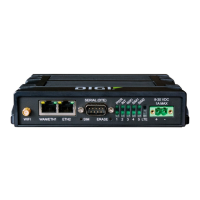Routing IProuting
IX20 User Guide
423
enable true
gateway 192.168.5.1
interface /network/interface/lan2
label new_static_route_1
metric 0
mtu 0
(config)>
4. Use the index number to delete the static route:
(config)> del network route static 0
(config)>
5. Save the configuration and apply the change
(config)> save
Configuration saved.
>
6. Type exit to exit the Admin CLI.
Depending on your device configuration, you may be presented with an Access selection
menu. Type quit to disconnect from the device.
Policy-based routing
Normally, a routing device determines how to route a network packet based on its destination
address. However, you can use policy-based routing to forward the packet based on other criteria,
such as the sourceof the packet. For example, you can configure the IX20 device so that high-priority
traffic isrouted through the cellular connection, while all other traffic is routed through an Ethernet
(WAN) connection.
Policy-based routing for the IX20 device usesthe following criteria to determine how to route traffic:
n
Firewall zone(for example, internal/outbound traffic, external/inbound traffic, or IPSec tunnel
traffic).
n
Network interface(for example, the cellular connection, the WAN, or the LAN).
n
IPv4 address.
n
IPv6 address.
n
MACaddress.
n
Domain.
n
Protocol type (TCP, UDP, ICMP, or all).
The order of the policies is important. Routing policies are processed sequentially; as a result, if a
packet matches an earlier policy, it will be routed using that policy’s rules. It will not be processed by
any subsequent rules.

